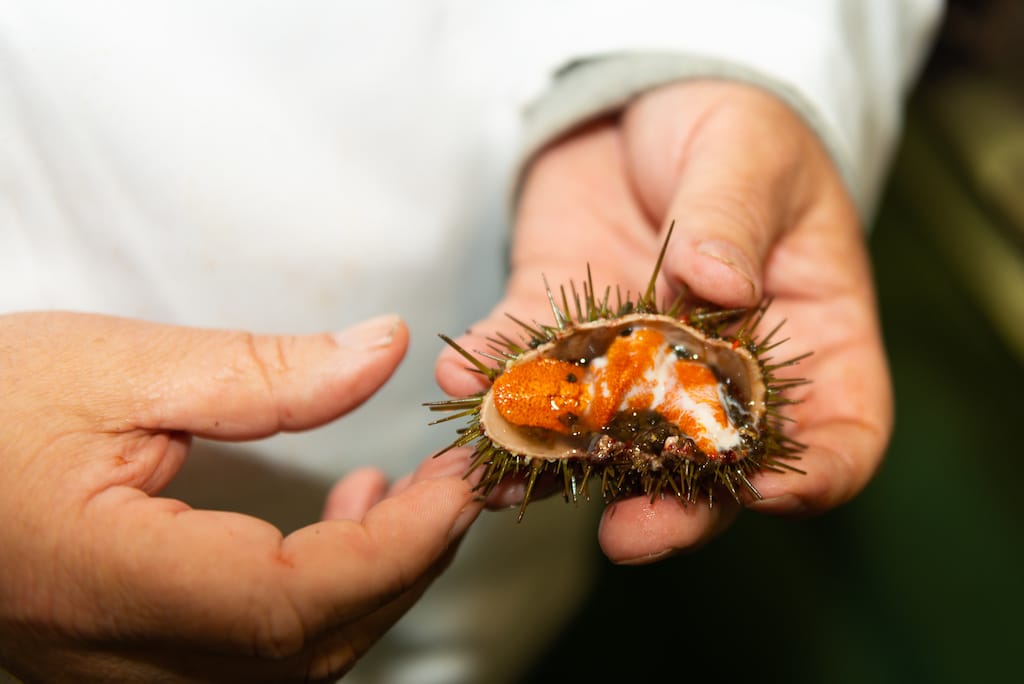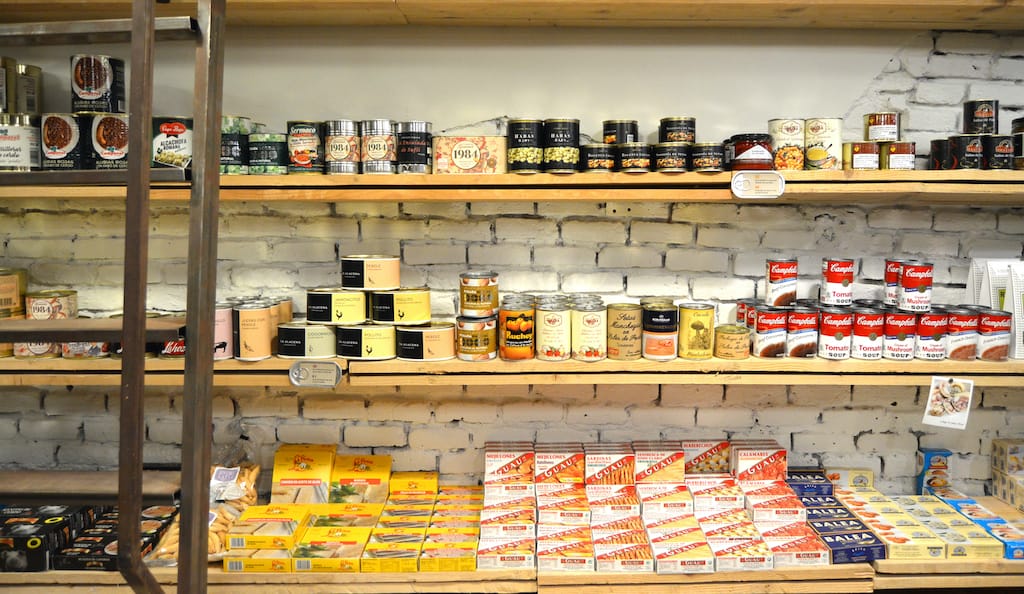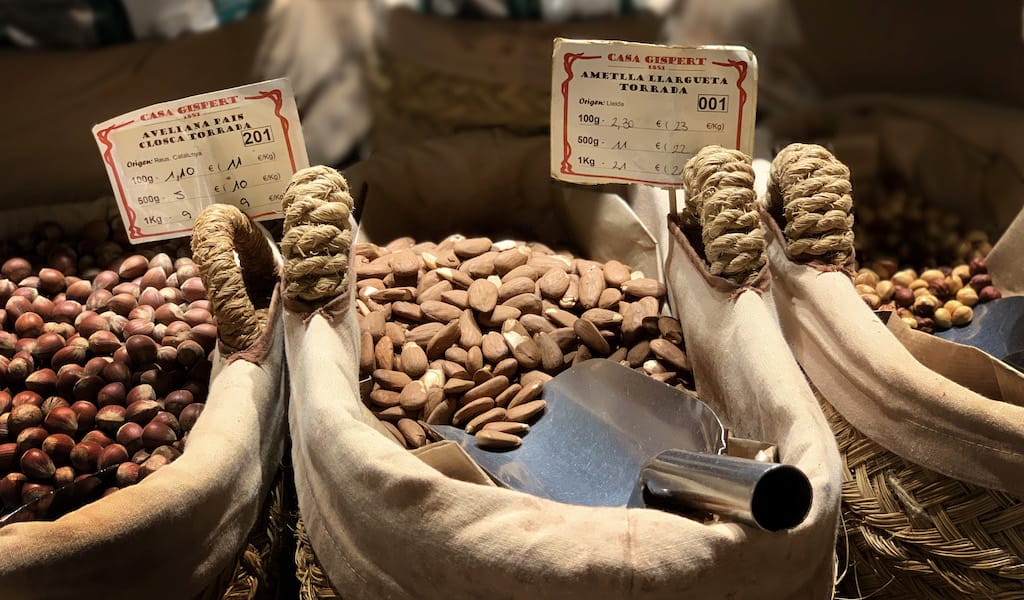Mention seafood from Galicia, and you can expect an almost Pavlovian response from a chef. This corner of northwestern Spain has a reputation as the source of Europe’s highest quality fish and shellfish. But not all of Galicia’s seafood makes it to fancy dinner plates; a significant amount ends up in tiny metal cans. But these aren’t the sardines you used to eat with Saltines in your broke college days; tinned seafood from this remote region of Spain is among the most sought-out and expensive in the world.
The History
How did out-of-the-way Galicia become the canned fish and seafood hotspot that it is today? To get an answer, we started with a visit to Mariña López Rodríguez, director of Museo de la Conserva, a museum in Vigo, Spain, dedicated to Galicia’s canning industry. She is giving us a private tour of the space, describing the antique canning machines, labels and fascinating old photographs on display – there’s even a recreated 1920s-era cannery office, as well as a corner dedicated to the technological evolution of the can opener. We ask her to tell us about the history of tinned seafood in Galicia and her prompt response is, “Which history do you want to know about?” Canned seafood, as we learn, has links with war, science, labor rights, technology and, of course, fishing.
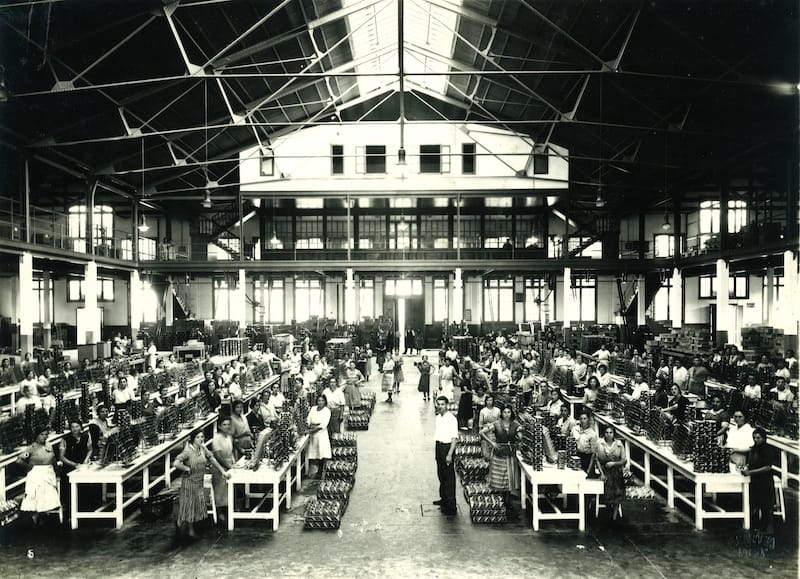
The short answer is that Galicia’s fertile coastline has drawn people in search of aquatic protein for millennia; the Basques hunted whales off the coast of Galicia as early as the Middle Ages. At the end of the 18th century, Catalans introduced sophisticated techniques for preserving fish with salt, establishing Galicia as an important source of seafood for the rest of Spain. In 1810, in response to a request by Napoleon for a portable food for warfare, Frenchman Nicolas François Appert introduced the technique of preserving food in hermetic sterile glass jars, which would later lead to canning. The metallic cans themselves were created in the UK. Around 30 years later, French entrepreneurs armed with canning experience started to open factories in Galicia, and the area’s canning industry was born. Massive growth continued until the 1960s, when advances in freezing and refrigeration reduced the demand for tinned fish. An interest in tuna in the 1970s led to a second wave of canning in Galicia, and these days, tuna continues to rule, although sardines, clams, cockles, razor clams, mussels and even sea urchin roe and seaweed are also preserved in tins, with today’s factories ranging in scale from the industrial to the artisanal.

Mariña takes me upstairs to the area where she and her colleagues clean and catalogue canned seafood paraphernalia. Their hope is to eventually have the museum’s entire archive online, with 3D images of each item available to the public. They also hope to move the museum from its current location in a university compound 10 kilometers outside of Vigo to an abandoned cannery near the center of town – itself an act of preservation. She shows us a black and white photo of a massive, stunning structure and says, “We want this one.”
The Catch
Iago Piñeiro groans as he pulls up a 12-meter rope encrusted with dozens of immature mussels. We’re on a batea, one of dozens of floating rafts located a brief boat ride from Vigo, Galicia’s largest city. The bateas are found in rías, fertile river outlets where fresh and saltwater mix, the sweet spot for shellfish. Iago’s colleagues transplant wild immature mussels or hatch seeds in “socks” hanging from the bateas, and after eight months, harvest full-grown mussels. With more than 3,000 bateas that produce more than 300,000 tons per year, Galicia produces 20 percent of the world’s mussels. Most of these are exported, while the remainder end up in Galicia’s canneries.
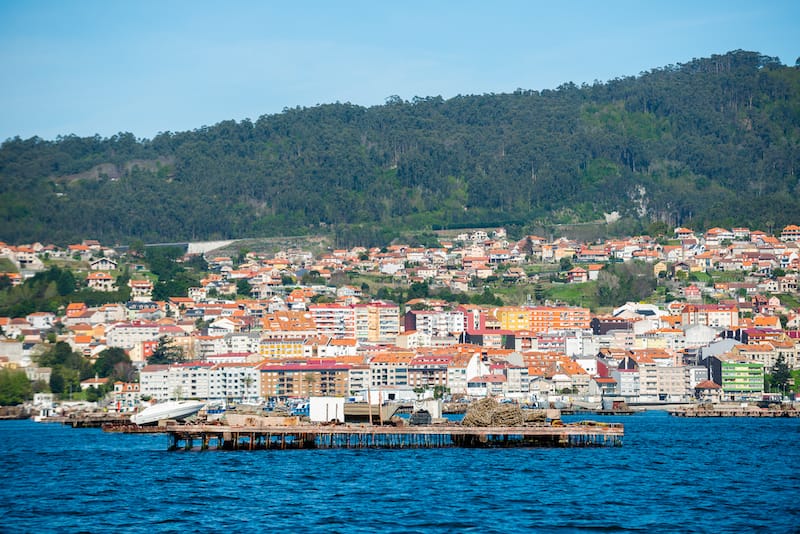
Sixty kilometers north, at the edge of a ría outside the village of Carril, a woman sorts shellfish. Behind her, the ground is blanketed with shells, the sandy shore divided into plots via low rock barriers topped with piles of seaweed. The plots are owned individually, and when the tide is low people comb the sandy soil with coarse rakes, selling what they find to the village’s collective seafood market. Cockles and white clams demand the highest prices while Manila clams, an invasive species, are less valuable.
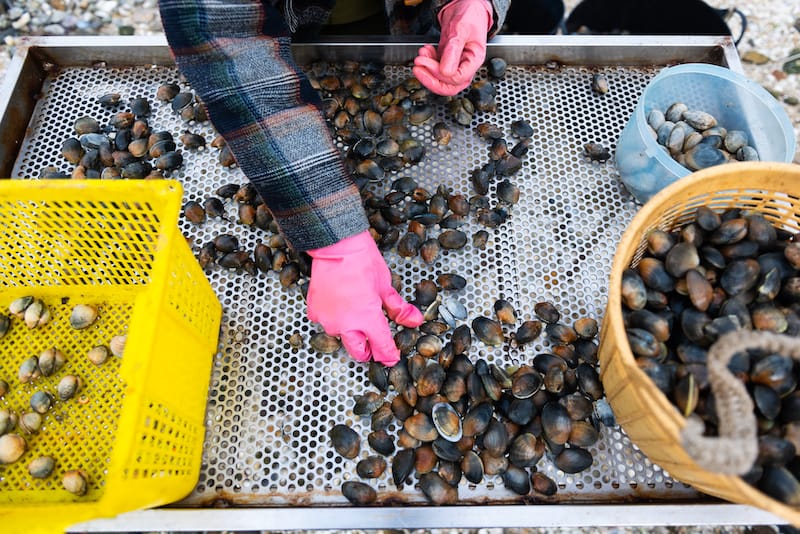
Elsewhere in Galicia, Antonio Muiños and his wife, Rosa Miraz, are likely wearing wetsuits and are conducting an entirely different kind of harvest, one under the water’s surface. Under the brand name Porto-Muiños, the pair are some of the first in Spain to can seaweed, something that in Galicia was previously considered little more than fertilizer. They hope to change the perception of this product, reminding people that seaweed is essentially the vegetable of the ocean.
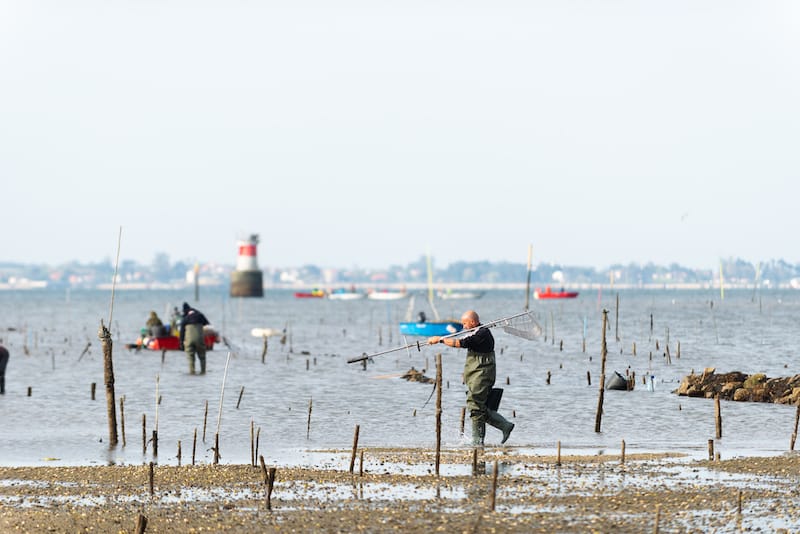
“Normally, seaweed is part of the diet of seafood,” Antonio tells us, pulling out his phone and showing us photos of fronds of seaweed that have been picked ragged by fish. “But people don’t see them together, you only see this when you go underwater.”
Porto-Muiños’s product line includes tins of pure seaweed, cans of pre-seasoned seaweed salad, and cans that contain combinations of shellfish and seaweed. The pair also forage plants that thrive in sandy, salty areas, and eventually hope to farm seaweed.
“The idea is to bring a bit more of the sea to the tin,” Antonio tells us.

The Cans
Inside the Los Peperetes cannery, in Carril, workers are sitting around a table, picking apart tuna caught in the Cantabrian Sea, off Spain’s north coast. They transfer the delicate flakes to slim, round cans which will then be topped with artisanal butter made from the milk of Jersey cows in Galicia. On a different day, they might have been combining razor clams and brine, sardines and virgin olive oil, or mussels and escabeche.
“We are the smallest cannery in Galicia, I think,” Says Belén Lorenzo Paz, of the company she owns along with her family. “We have 12 workers; others have hundreds. The process here is manual; others use machines.”
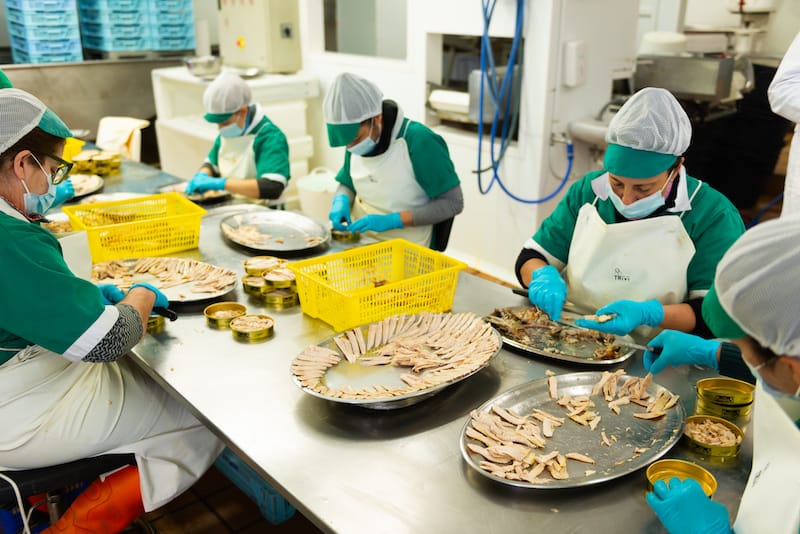
Indeed, the space where the various sauces are made is probably not much bigger than a home kitchen. Century-old machinery is still used to seal the cans, and the brand’s handsome labels are applied by hand. But all this meticulous attention to detail raised, for us at least, one fundamental question: why can seafood? Isn’t it supposed to be eaten fresh?
“The flavor of seafood can be even better when served this way,” Belén tells us. “A can of seafood is better after four years. The seafood combines with the olive oil and gains other flavors and textures and becomes a better product – like a wine!” Her colleague’s face lights up as he recounts the time that he ate a tin that had been sealed way back in 1982.
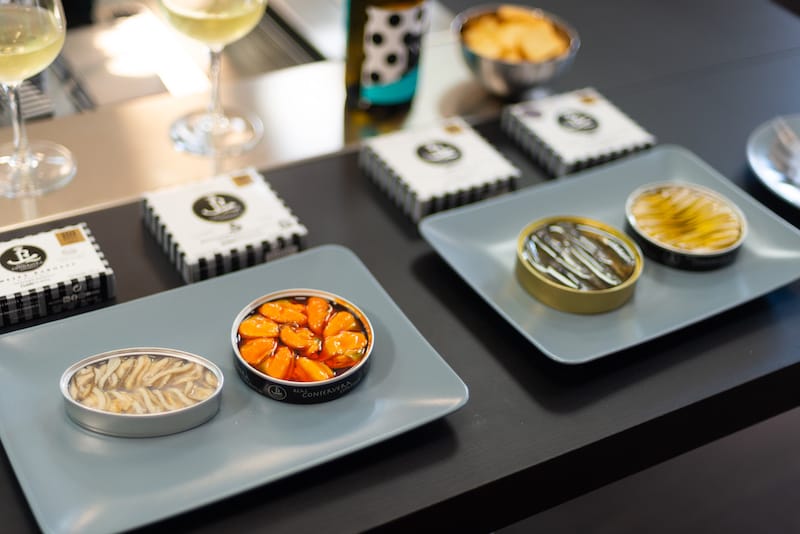
Similar magic is happening on a slightly larger scale at Real Conservera Española, another acclaimed Galician cannery. Although still considered a small factory, it produces 3,000 cans per day, nearly six times the typical daily output of Los Peperetes. In a nondescript, inland industrial park, the process begins when clams, razor clams, cockles and mussels are boiled, while sardines and other fish are slowly toasted in ovens.
“The main reason we toast is to preserve the texture of the fish,” explains Antonio Caballero, head of the company’s export department, who is giving us a tour of the factory. “It softens the bones – you don’t know that they’re there. It also allows the skin to be retained.”
Prepared, the fish and shellfish are then added to tins – in the case of mollusks, sometimes within 24 hours of having been caught – topped with brine, olive oil or a house-made sauce, sealed and sterilized. Real Conservera Española’s products, which have distinctive black-and-white packaging and are exported to 20 countries, have won several prizes at competitions.
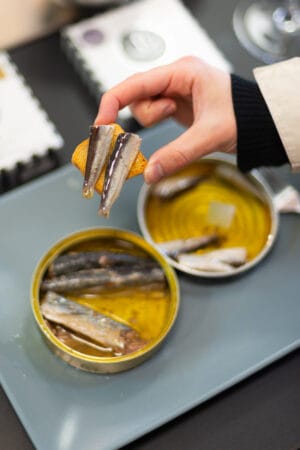
The Meal
At Real Conservera Española, we’re escorted to a lounge-like room for a tinned seafood tasting. There’s a can of mussels, beautifully arranged in a “flower” shape and suspended in a bright red, barely spicy, slightly tart escabeche. Another can holds a ring of tiny sardines, each smaller than a child’s pinky finger yet with a disproportionately rich flavor and a pleasant aroma from the olive oil. And there’s a round tin of the brand’s most expensive product, clams in brine – pure, delicate and subtle.
“Fresh and canned seafood are not better or worse, they’re different,” says Antonio, reminding us that we should regard canning seafood for what it is: a cooking method.
Several days later, in A Coruña, on Galicia’s northern coast, we visit Chef Álvaro Victoriano. Among the wheels of cheese and bottles of olive oil in the display at his restaurant, Ultramarinos Galera, we spot the distinctively round tins of Los Perperetes. Yet the chef tells us that he struggles to sell the cans to locals.
“Even though there’s so much good quality tinned seafood in Galicia, people here prefer fresh fish,” says the chef, explaining that this is in contrast with cities like Madrid and Barcelona, where there are entire bars dedicated to tinned seafood. “[In Galicia] it’s hard to get them to eat cans.”
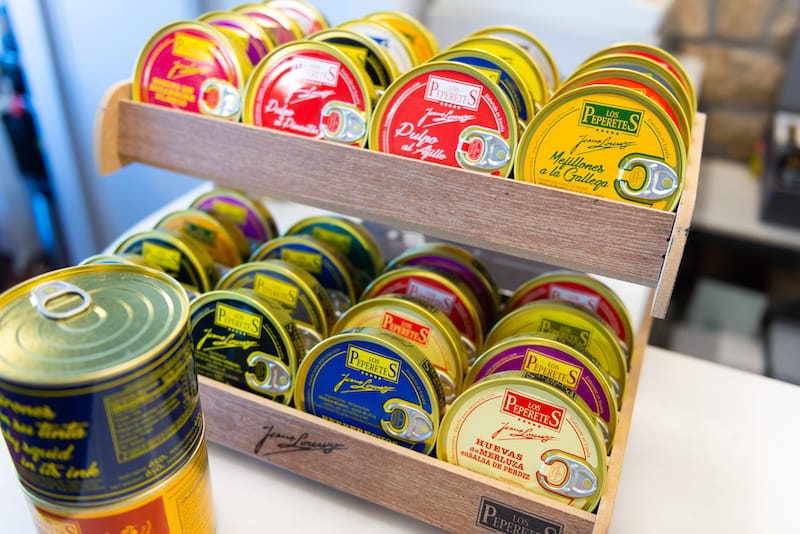
Instead, Chef Álvaro uses Galicia’s tinned seafood in an almost surreptitious way to compliment dishes: he tops the ubiquitous Russian salad with a chunk of high-quality tinned tuna loin; a “Bolognese” of vegetables is made with minced canned razor clams; and he serves a delicate broth studded with tinned cockles.
Back home, we slice a loaf of bread and open a can of Porto-Muiñoz’s razor clams in brine with “sea spaghetti” (a spindly seaweed), and another containing a mix of three types of seaweed in olive oil. Almost instantly, we’re transported to the coast of Galicia – to the iodine aroma of the seaweed, the briny taste of the sea. Weeks later and hundreds of kilometers away, it’s all there, preserved in that can.
(Note: A number of the kinds of people and places described in this piece can be experienced first-hand through Culinary Backstreets’ “Barnacles, Bluffs and Brine” trip to Galicia. More information here.)
 June 24, 2022 Conservas
June 24, 2022 Conservas
In Spain, conservas, or foods preserved in cans and jars, are not simply a matter of […] Posted in Barcelona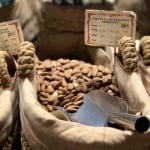 September 23, 2020 Casa Gispert
September 23, 2020 Casa Gispert
The scent of wood slowly burning is imbued with a sense of home and refuge: It calls to […] Posted in Barcelona January 10, 2019 Entrelatas
January 10, 2019 Entrelatas
Just as moments in time can be captured by a photograph, to savor at a later date, so […] Posted in Barcelona
Austin BushAustin Bush
Published on June 07, 2023
Related stories
June 24, 2022
BarcelonaIn Spain, conservas, or foods preserved in cans and jars, are not simply a matter of economic survival or a source of basic nutrition for students, hikers, military recruits and the like. Rather, the tradition of conservas more resembles that of keeping one’s most beautiful jewelry locked safe in a strongbox – a prized possession…
September 23, 2020
BarcelonaThe scent of wood slowly burning is imbued with a sense of home and refuge: It calls to mind the fireplace around which people used to congregate at the end of the day, or the barbecues and grills that still commonly serve as gathering points. This feeling can also be concentrated in bites of food,…
Explore the proudly Catalan district of Gràcia on our Made in Catalonia walk!
January 10, 2019
BarcelonaJust as moments in time can be captured by a photograph, to savor at a later date, so too can the freshest meats and produce – almost equally as fleeting – be preserved (albeit in a can) for enjoyment later down the line. Only we can’t guarantee that they’ll last as long, given how good they…







































